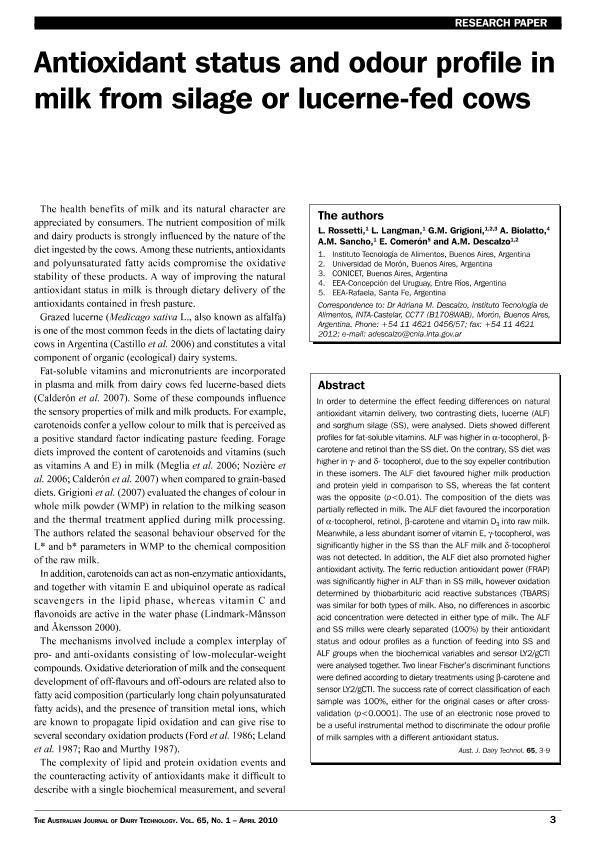Artículo
Antioxidant status and odor profile in milk from silage or alfalfa-fed cows
Rossetti, L.; Langman, Leandro Ezequiel; Grigioni, Gabriela Maria ; Biolatto, Andrea; Sancho, Ana Maria; Comeron, Eduardo Alberto; Descalzo, Adriana Maria
; Biolatto, Andrea; Sancho, Ana Maria; Comeron, Eduardo Alberto; Descalzo, Adriana Maria
 ; Biolatto, Andrea; Sancho, Ana Maria; Comeron, Eduardo Alberto; Descalzo, Adriana Maria
; Biolatto, Andrea; Sancho, Ana Maria; Comeron, Eduardo Alberto; Descalzo, Adriana Maria
Fecha de publicación:
04/2010
Editorial:
Dairy Industry Assoc Australia
Revista:
Australian Journal Of Dairy Technology
ISSN:
0004-9433
Idioma:
Inglés
Tipo de recurso:
Artículo publicado
Clasificación temática:
Resumen
In order to determine the effect feeding differences on natural antioxidant vitamin delivery, two contrasting diets, lucerne (ALF) and sorghum silage (SS), were analysed. Diets showed different profiles for fat-soluble vitamins. ALF was higher in α-tocopherol, βcarotene and retinol than the SS diet. On the contrary, SS diet was higher in γ- and δ- tocopherol, due to the soy expeller contribution in these isomers. The ALF diet favoured higher milk production and protein yield in comparison to SS, whereas the fat content was the opposite (p<0.01). The composition of the diets was partially reflected in milk. The ALF diet favoured the incorporation of α-tocopherol, retinol, β-carotene and vitamin D3 into raw milk. Meanwhile, a less abundant isomer of vitamin E, γ-tocopherol, was significantly higher in the SS than the ALF milk and δ-tocopherol was not detected. In addition, the ALF diet also promoted higher antioxidant activity. The ferric reduction antioxidant power (FRAP) was significantly higher in ALF than in SS milk, however oxidation determined by thiobarbituric acid reactive substances (TBARS) was similar for both types of milk. Also, no differences in ascorbic acid concentration were detected in either type of milk. The ALF and SS milks were clearly separated (100%) by their antioxidant status and odour profiles as a function of feeding into SS and ALF groups when the biochemical variables and sensor LY2/gCTI were analysed together. Two linear Fischer’s discriminant functions were defined according to dietary treatments using β-carotene and sensor LY2/gCTI. The success rate of correct classification of each sample was 100%, either for the original cases or after crossvalidation (p<0.0001). The use of an electronic nose proved to be a useful instrumental method to discriminate the odour profile of milk samples with a different antioxidant status.
Palabras clave:
MILK
,
ANTIOXIDANT
,
ODOUR
Archivos asociados
Licencia
Identificadores
Colecciones
Articulos(SEDE CENTRAL)
Articulos de SEDE CENTRAL
Articulos de SEDE CENTRAL
Citación
Rossetti, L.; Langman, Leandro Ezequiel; Grigioni, Gabriela Maria; Biolatto, Andrea; Sancho, Ana Maria; et al.; Antioxidant status and odor profile in milk from silage or alfalfa-fed cows; Dairy Industry Assoc Australia; Australian Journal Of Dairy Technology; 65; 1; 4-2010; 3-9
Compartir



